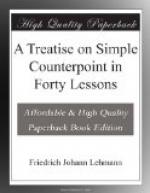The unison is permitted on the weak beat. [Fig. 24.]
[Illustration: Fig. 24.]
Avoid broken-chord effects, that is, do not use more than three tones belonging to the same chord in succession. [Fig. 25.]
[Illustration: Fig. 25.]
Avoid frequent skipping of parts. [Fig. 26.]
[Illustration: Fig. 26.]
Parts may cross occasionally, but should return immediately [Fig. 27.]
[Illustration: Fig. 27.]
Consecutive fifths or octaves on consecutive strong beats are bad; but they are good on the weak beats if the second fifth or octave is approached in the opposite direction from the first. [Fig. 28.]
[Illustration: Fig. 28.]
In minor the sixth degree may occasionally be raised on the strong beat, if it is desired to proceed upward to the raised seventh degree. [Fig. 29.]
[Illustration: Fig. 29.]
In the last measure but one, both the supertonic and leading tone should appear. [Fig. 30.]
[Illustration: Fig. 30.]
Three notes may be written to one of the cantus firmus, as in Fig. 31. For this no new rules are required.
[Illustration: Fig. 31.]
The cadences in Fig. 32 are good. It will be seen that the cadences of the first species may also be used.
[Illustration: Fig. 32.]
EXERCISES
To cantus firmus a write two counterpoints above and two below in the first species.
To cantus firmus b write two above and two below in the second species.
CANTI FIRMI
[Illustration: Fig. 33.]
LESSON III
SECOND SPECIES IN BOTH PARTS[1]
[Illustration: Fig. 34.]
[1] In this and similar cases the term “species” will be understood as referring simply to the number of notes, or to the note-combinations, of the contrapuntal part or parts in question. “Second species in both parts” means, therefore, that both parts progress in half-notes.
When writing second species in both parts no cantus firmus is used, both parts being original. One part begins on the first beat, the other may begin on either the first or second beat. [Fig. 35.]
[Illustration: Fig. 35.]
The interval formed by the two notes appearing on the second beat should be a consonance, or one of the following dissonances: The augmented fourth, the diminished fifth, the minor or diminished seventh when properly resolved, and the perfect fourth when approached in contrary motion.
All tones not belonging to the harmony implied on the first beat, must be treated as dissonances. [Fig. 36.]
[Illustration: Fig. 36.]
The seventh or ninth of the implied harmony of a measure, when approached in an upward direction, may be used in either part, provided it is consonant with the other part, or comes within the requirements of the exceptions. [Fig. 37.]




